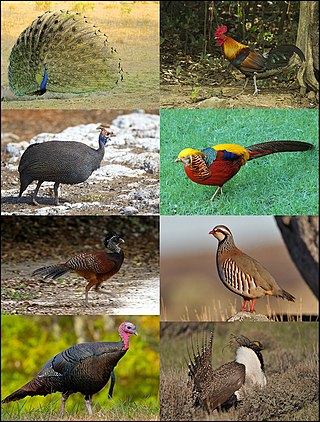
Galliformes is an order of heavy-bodied ground-feeding birds that includes turkeys, chickens, quail, and other landfowl. Gallinaceous birds, as they are called, are important in their ecosystems as seed dispersers and predators, and are often reared by humans for their meat and eggs, or hunted as game birds.

Guineafowl are birds of the family Numididae in the order Galliformes. They are endemic to Africa and rank among the oldest of the gallinaceous birds. Phylogenetically, they branched off from the core Galliformes after the Cracidae and before the Odontophoridae. An Eocene fossil lineage Telecrex has been associated with guineafowl; Telecrex inhabited Mongolia, and may have given rise to the oldest of the true phasianids, such as blood pheasants and eared pheasants, which evolved into high-altitude, montane-adapted species with the rise of the Tibetan Plateau. While modern guineafowl species are endemic to Africa, the helmeted guineafowl has been introduced as a domesticated bird widely elsewhere.
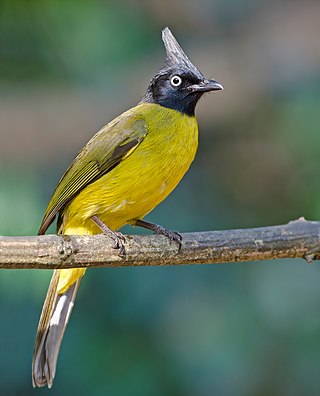
The black-crested bulbul is a member of the bulbul family of passerine birds. It is found from the Indian subcontinent to southeast Asia.

The Eastern Highlands, also known as the Manica Highlands, is a mountain range on the border of Zimbabwe and Mozambique. The Eastern Highlands extend north and south for about 300 kilometres (190 mi) through Zimbabwe's Manicaland Province and Mozambique's Manica Province.
Jacques Pucheran was a French zoologist born in Clairac. He was a grandnephew to physiologist Étienne Serres (1786-1868).

The kalij pheasant, or simply kalij, is a pheasant found in forests and thickets, especially in the Himalayan foothills, from Nepal, Pakistan to western Thailand. Males are rather variable depending on the subspecies involved, but all have at least partially glossy bluish-black plumage, while females are overall brownish. Both sexes have a bare red face and greyish legs. It is generally common and widespread, though three of its eastern subspecies are considered threatened and L. l. moffitti is virtually unknown in the wild. On 21 October 2021, the Government of Jammu and Kashmir declared Kalij Pheasant as bird of the Union Territory of Jammu and Kashmir.

Jerdon's baza is a moderate sized brown hawk with a thin white-tipped black crest usually held erect. It is found in South-east Asia. It inhabits foothills in the terai and is rarer in evergreen forests and tea estates.

The crested guineafowl are a group of three species and members of the Numididae, the guineafowl bird family. They are found in open forest, woodland and forest-savanna mosaics in sub-Saharan Africa.

Guttera is a genus of birds in the family Numididae. Established by Johann Georg Wagler in 1832, it contains four species:

The plumed guineafowl is a member of the guineafowl bird family. It is found in humid primary forest in Central Africa. It resembles some subspecies of the crested guineafowl, but has a straighter and higher crest, and a relatively long wattle on either side of the bill. The bare skin on the face and neck is entirely dull grey-blue in the western nominate subspecies, while there are a few orange patches among the grey-blue in the eastern subspecies schubotzi.
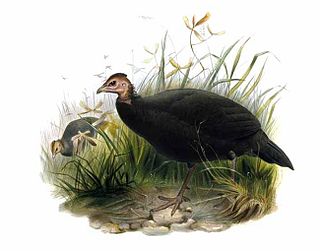
The black guineafowl is a terrestrial bird of the Numididae (guineafowl) family found in humid forests in West-Central Africa. It is a medium-sized, black galliforme bird with a bare, orange-pink head and upper neck. As it inhabits dense, potentially inaccessible, regions of equatorial African jungle, little is known of black guineafowl behaviour or habits. By all accounts, it is a more reclusive, secretive bird when compared to the other, more sociable guineafowl species; i.e., researchers have been able to successfully observe and document far more information on the confident, gregarious and open grassland-dwelling helmeted guineafowl, or even the more exotic vulturine guineafowl. Compared to the black guineafowl, the aforementioned species tend to be found in more exposed, dry savanna and arid open forest habitat, and congregate in larger communal flocks. Black guineafowl are seemingly very wary birds, living in smaller social groups than other guineafowl, and are constantly looking for signs of danger—the slightest hint of which will send the group darting into the bush to hide.
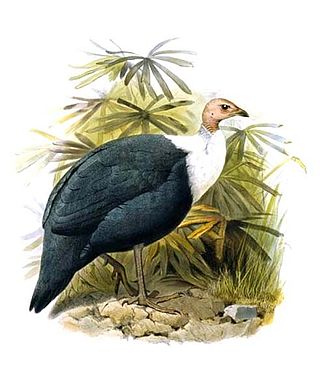
The white-breasted guineafowl is a medium-sized, up to 45 cm long, terrestrial bird of the guineafowl family.

The glittering-bellied emerald is a species of hummingbird in the "emeralds", tribe Trochilini of subfamily Trochilinae. It is found in Argentina, Bolivia, Brazil, Paraguay, and Uruguay.

The blue-mantled crested flycatcher or African crested flycatcher is a species of bird in the family Monarchidae found in eastern and south-eastern Africa.
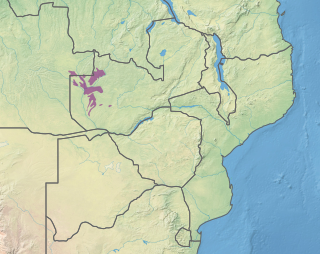
The Zambezian evergreen dry forests, also known as the Zambezian Cryptosepalum dry forest, is a tropical dry broadleaf forest ecoregion of Southern Africa. It consists of several areas of thick forest in western Zambia and adjacent Angola. It is one of the largest areas of tropical evergreen forest outside the equatorial zone.

The Karkloof Forest is situated in the Karkloof Nature Reserve, 22 km north of Howick, KwaZulu-Natal, South Africa.
Guineafowl are birds of the family Numididae, including:

The Vietnamese crested argus is a large and spectacular peafowl-like species of bird in the pheasant family with dark-brown-spotted black and buff plumage, a heavy pink bill, brown irises and blue skin around the eyes. The head has two crests; the hind crest, which extends down the occiput, is erected when alarmed and during intentional behaviors including pair bonding and courtship displays. The male has a broad and greatly elongated tail of twelve feathers. The tail covert of the male is the longest of any bird and is believed to contain the longest feathers to occur in a wild bird; the Reeves's pheasant has tail feathers of similar length but which are considerably narrower. The tail coverts measure up to 1.73 m (5.7 ft) in length, giving the bird a total length of 1.9–2.39 m (6.2–7.8 ft).
The western crested guineafowl is a member of the Numididae, the guineafowl bird family. It is found in open forest, woodland and forest-savanna mosaics. It was previously known as the crested guineafowl when the three species were lumped together. The eastern crested guineafowl is found from Guinea-Bissau to Cameroon, Kenya, Zambia, and Angola.

The southern crested guineafowl is a member of the Numididae, the guineafowl bird family. It is found in open forest, woodland and forest-savanna mosaics. It was previously known as the crested guineafowl when the three species were lumped together. The eastern crested guineafowl is found from Tanzania to South Africa.


















